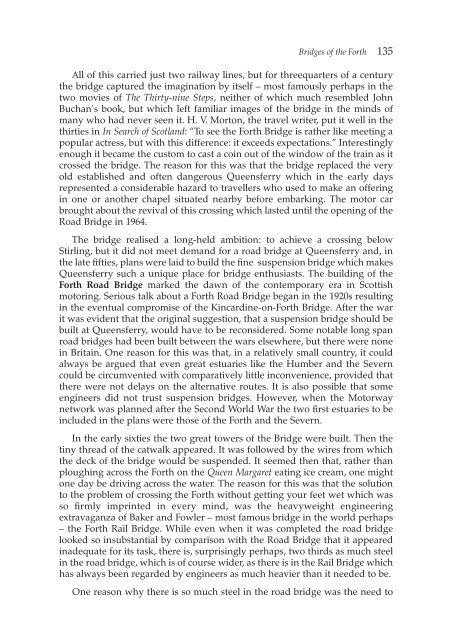the Forth Naturalist Historian - Forth Naturalist and Historian ...
the Forth Naturalist Historian - Forth Naturalist and Historian ...
the Forth Naturalist Historian - Forth Naturalist and Historian ...
You also want an ePaper? Increase the reach of your titles
YUMPU automatically turns print PDFs into web optimized ePapers that Google loves.
Bridges of <strong>the</strong> <strong>Forth</strong> 135<br />
All of this carried just two railway lines, but for threequarters of a century<br />
<strong>the</strong> bridge captured <strong>the</strong> imagination by itself – most famously perhaps in <strong>the</strong><br />
two movies of The Thirty-nine Steps, nei<strong>the</strong>r of which much resembled John<br />
Buchan’s book, but which left familiar images of <strong>the</strong> bridge in <strong>the</strong> minds of<br />
many who had never seen it. H. V. Morton, <strong>the</strong> travel writer, put it well in <strong>the</strong><br />
thirties in In Search of Scotl<strong>and</strong>: “To see <strong>the</strong> <strong>Forth</strong> Bridge is ra<strong>the</strong>r like meeting a<br />
popular actress, but with this difference: it exceeds expectations.” Interestingly<br />
enough it became <strong>the</strong> custom to cast a coin out of <strong>the</strong> window of <strong>the</strong> train as it<br />
crossed <strong>the</strong> bridge. The reason for this was that <strong>the</strong> bridge replaced <strong>the</strong> very<br />
old established <strong>and</strong> often dangerous Queensferry which in <strong>the</strong> early days<br />
represented a considerable hazard to travellers who used to make an offering<br />
in one or ano<strong>the</strong>r chapel situated nearby before embarking. The motor car<br />
brought about <strong>the</strong> revival of this crossing which lasted until <strong>the</strong> opening of <strong>the</strong><br />
Road Bridge in 1964.<br />
The bridge realised a long-held ambition: to achieve a crossing below<br />
Stirling, but it did not meet dem<strong>and</strong> for a road bridge at Queensferry <strong>and</strong>, in<br />
<strong>the</strong> late fifties, plans were laid to build <strong>the</strong> fine suspension bridge which makes<br />
Queensferry such a unique place for bridge enthusiasts. The building of <strong>the</strong><br />
<strong>Forth</strong> Road Bridge marked <strong>the</strong> dawn of <strong>the</strong> contemporary era in Scottish<br />
motoring. Serious talk about a <strong>Forth</strong> Road Bridge began in <strong>the</strong> 1920s resulting<br />
in <strong>the</strong> eventual compromise of <strong>the</strong> Kincardine-on-<strong>Forth</strong> Bridge. After <strong>the</strong> war<br />
it was evident that <strong>the</strong> original suggestion, that a suspension bridge should be<br />
built at Queensferry, would have to be reconsidered. Some notable long span<br />
road bridges had been built between <strong>the</strong> wars elsewhere, but <strong>the</strong>re were none<br />
in Britain. One reason for this was that, in a relatively small country, it could<br />
always be argued that even great estuaries like <strong>the</strong> Humber <strong>and</strong> <strong>the</strong> Severn<br />
could be circumvented with comparatively little inconvenience, provided that<br />
<strong>the</strong>re were not delays on <strong>the</strong> alternative routes. It is also possible that some<br />
engineers did not trust suspension bridges. However, when <strong>the</strong> Motorway<br />
network was planned after <strong>the</strong> Second World War <strong>the</strong> two first estuaries to be<br />
included in <strong>the</strong> plans were those of <strong>the</strong> <strong>Forth</strong> <strong>and</strong> <strong>the</strong> Severn.<br />
In <strong>the</strong> early sixties <strong>the</strong> two great towers of <strong>the</strong> Bridge were built. Then <strong>the</strong><br />
tiny thread of <strong>the</strong> catwalk appeared. It was followed by <strong>the</strong> wires from which<br />
<strong>the</strong> deck of <strong>the</strong> bridge would be suspended. It seemed <strong>the</strong>n that, ra<strong>the</strong>r than<br />
ploughing across <strong>the</strong> <strong>Forth</strong> on <strong>the</strong> Queen Margaret eating ice cream, one might<br />
one day be driving across <strong>the</strong> water. The reason for this was that <strong>the</strong> solution<br />
to <strong>the</strong> problem of crossing <strong>the</strong> <strong>Forth</strong> without getting your feet wet which was<br />
so firmly imprinted in every mind, was <strong>the</strong> heavyweight engineering<br />
extravaganza of Baker <strong>and</strong> Fowler – most famous bridge in <strong>the</strong> world perhaps<br />
– <strong>the</strong> <strong>Forth</strong> Rail Bridge. While even when it was completed <strong>the</strong> road bridge<br />
looked so insubstantial by comparison with <strong>the</strong> Road Bridge that it appeared<br />
inadequate for its task, <strong>the</strong>re is, surprisingly perhaps, two thirds as much steel<br />
in <strong>the</strong> road bridge, which is of course wider, as <strong>the</strong>re is in <strong>the</strong> Rail Bridge which<br />
has always been regarded by engineers as much heavier than it needed to be.<br />
One reason why <strong>the</strong>re is so much steel in <strong>the</strong> road bridge was <strong>the</strong> need to



